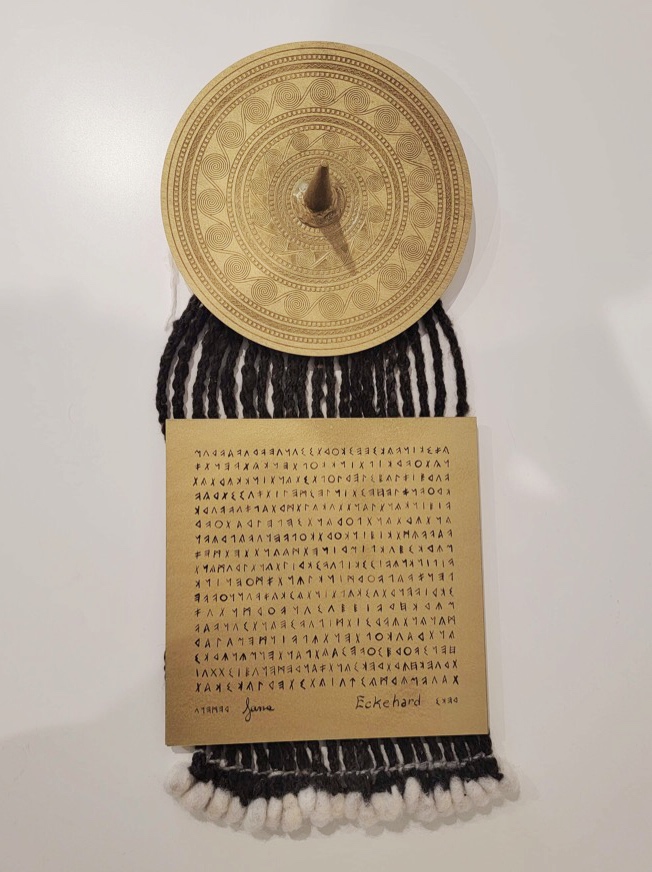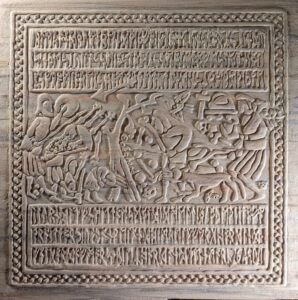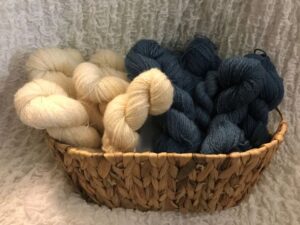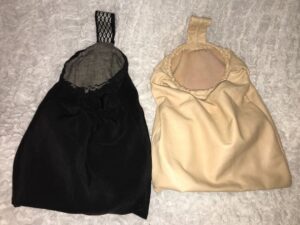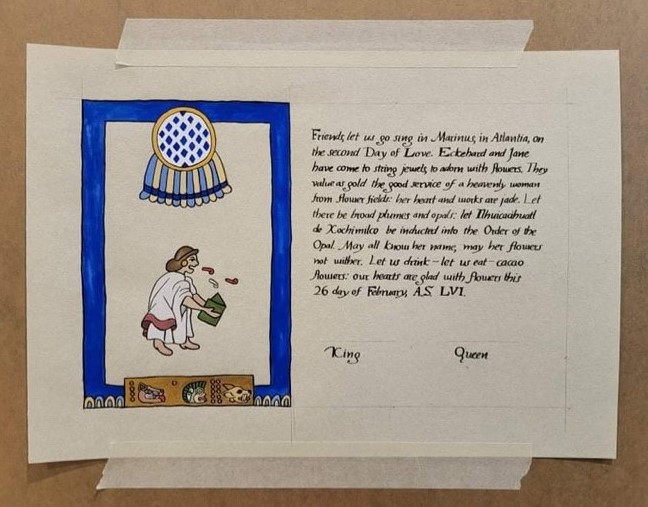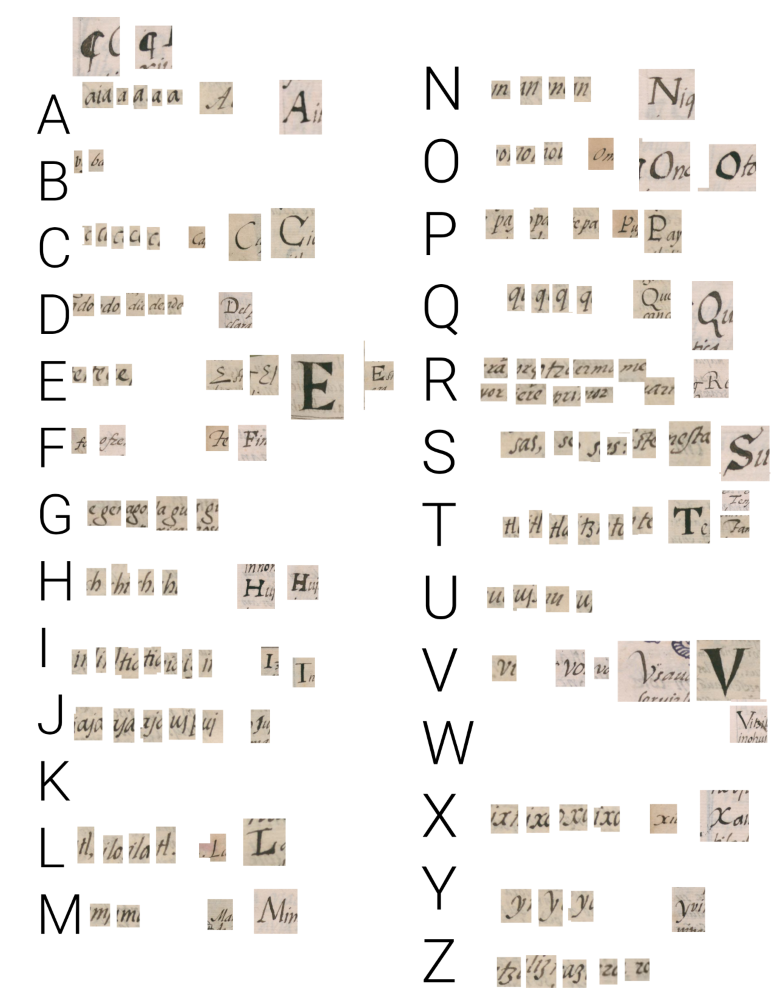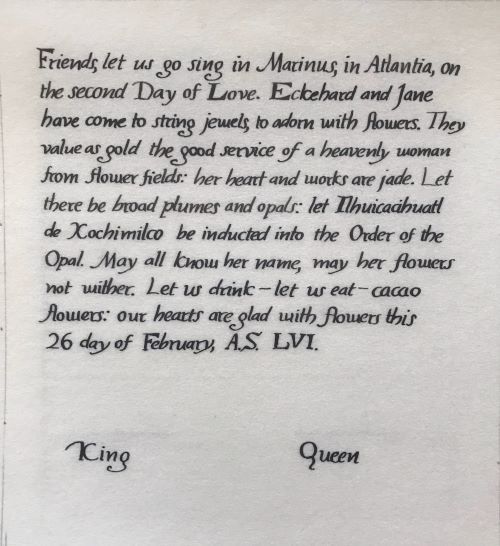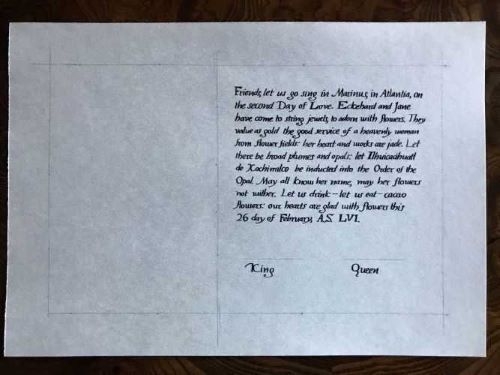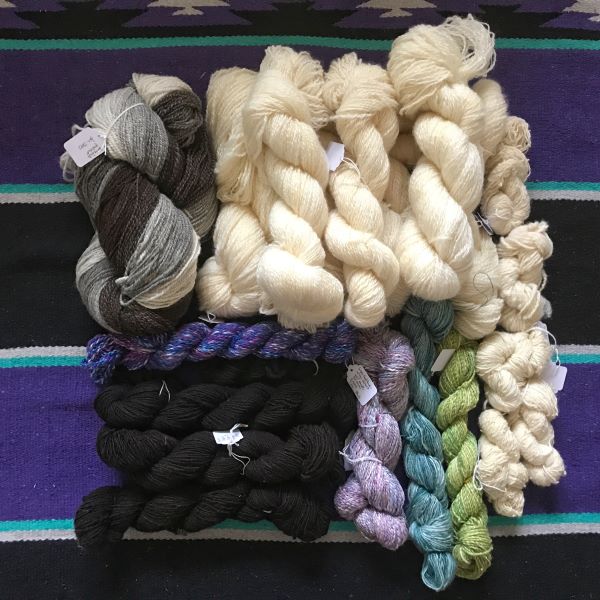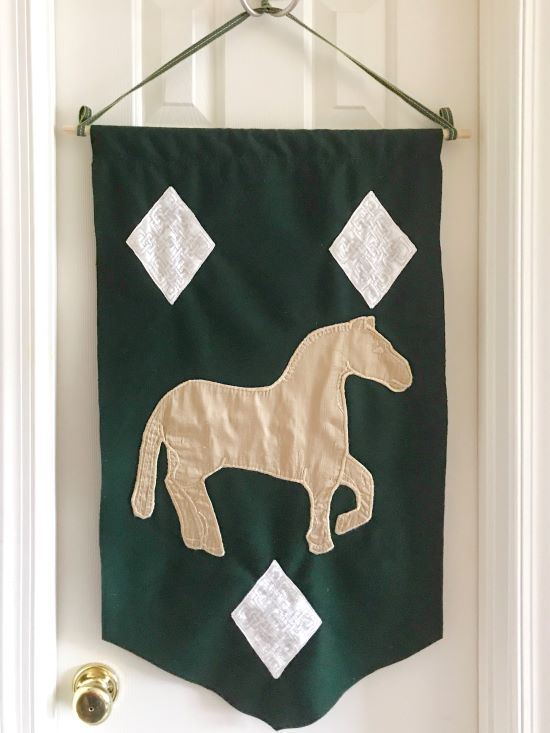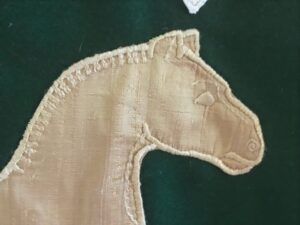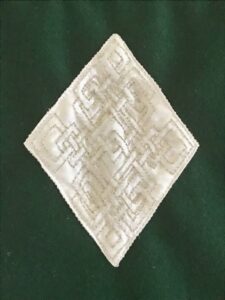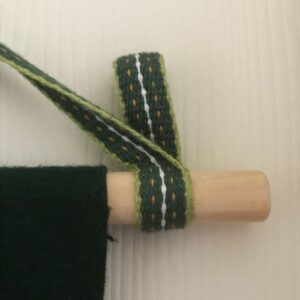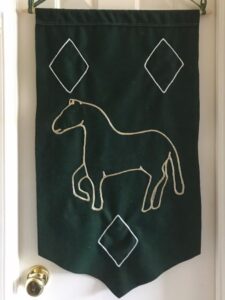April is National Poetry Month, so I decided to post as often as possible with a little bit about poetry! Here are the posts:
1: Introduction & Shakespeare
Greetings, Atlantia! While many folks are celebrating at Coronation, I did not want to let today slip away without noting that April is National Poetry Month! As your Poeta for a little longer, I hope to post bits and pieces about poetry throughout this month, as time allows. But let’s not wait: today, I want to talk about Shakespeare!
Love him or hate him, Shakespeare’s works have had an immeasurable influence. While there is much to say about his poetry, I want to highlight Shakespeare’s use of verse in his plays. In these, he masterfully combines prose and verse; transitions between these forms (as well as between different kinds of verse) can give us clues about a character’s personality, status, or even changing thoughts.
This article from the British Library provides an excellent overview along with many interesting examples of how shifts between prose and poetry convey information to the audience. With his life straddling the end of our time period, Shakespeare makes a perfect start to National Poetry Month!
2: Aristotle’s Poetics
Greetings, Atlantia! On the second day of National Poetry Month, I’m thinking about the theory of poetry, specifically, De Poetica (Poetics) by Aristotle, one of the first known works on literary theory. Indeed, while there are a great many opinions about this ancient work (dating to around 335 BCE), it still has a strong influence on modern conceptions of narrative. While too complex to boil down in a short post (and I’m certainly no expert), its emphasis on tragedy and comedy still affects how we divide genres of stories. Indeed, as I was considering what to write about for this month, I found myself categorizing poems as comedy, tragedy, lyric, and epic, all categories that Aristotle identified (indeed, the points where I struggled to apply this Westernized conception of poetry was with forms that originated outside Europe — but let’s not get ahead of ourselves!). That said, I find it interesting that the parts of Aristotle’s Poetics that survive are primarily thanks to Ibn Rushd, a twelfth-century Andalusian scholar that some folks may known better via his Latinized name, Averroes. If you’d like to deep-dive into the text of De Poetica yourself, you can read it for free here. While it’s quite short, there is much to be gleaned and argued over!
3: Epic of Gilgamesh
What was intended: share with Atlantia a bit about the Epic of Gilgamesh, as the oldest surviving epic poem, for the third day of National Poetry Month! What actually happened: I ended up in a deep, deep rabbit hole discovering way more than I ever intended about Akkadian and Sumerian poetry and mythology. Oops.
While the Epic of Gilgamesh is billed as the oldest surviving epic poem, the best surviving copies date to 600s BCE; however, different versions have been dated to between 1200s-900s BCE (the Standard Babylonian version) and even around 1700s BCE (the Old Babylonian version). This full epic, written in Akkadian, is in fact pre-dated by five earlier poems written in Sumerian (dating to ~2100 BCE); of these, the majority appear in some form in the longer, later epic, while the others are echoed thematically if not specifically.
Episodic in nature, the first half of the poem is centered around the friendship of Gilgamesh (a king) and Enkidu (a former wild man). Thousands-years-spoilers: Enkidu dies at the end of this part, triggering the second half, wherein Gilgamesh seeks both eternal life and youth. While he finds his immortal ancestor, Utnapishtim, who rescued mortal life during a Great Flood, he finds that immortality is beyond the reach of him and all humanity. This summary, however, does not do the epic justice; I recommend perusing the many summaries online or some of the links below.
For me, one of my most interesting discoveries was that scholars are still unsure how the poetic form of the Standard Babylonian version actually functioned, though they agree that parallelism is an important feature. This is divided into repetitive (repeating phrases), progressive (using different imagery to say the same thing), and incremental (adding additional detail to repetitive phrases). These all create slightly different meaning and texture in the verse while emphasizing important aspects.
Some links for more information:
4: Mahabharata
Continuing with epics on day four of National Poetry Month, let’s talk about the Mahābhārata! The Mahābhārata is the longest-ever epic poem, with the longest version reaching 200,000 lines! With a number of framing devices within the 18 sections or books, the larger poem contains other important shorter texts, including the Bhagavad Gita and a short version of the Rāmāyana. It is composed of shloka, 32-syllable couplets that can be divided into half-verses or quarter-verses. While some sections are as old as 400 BCE, the story itself is believed to be set between the 9th and 8th centuries BCE. It is a delightfully complex tale full of familial, political, and cosmic drama, with the purported author Vyasa also appearing as a character. Focusing on two specific branches of the ruling family of Hastinapura as they struggle for the throne, the story is an incredibly important piece of literature in Hinduism. Indeed, as a non-expert, there’s no way I can do this incredibly important epic justice, but this 60-second synopsis made me cackle in glee. For a longer version, this seems to be a good video. And, as with Gilgamesh, Wikipedia continues to have a really good synopsis. I hope you take a second to explore further about the Mahābhārata — it’s enriching!
5: Beowulf
Y’all should have placed bets on how long it would take me to get to Beowulf during National Poetry Month.
Anyway! While the manuscript for Beowulf (Cotton Vitellius A.xv — but I won’t get distracted by the Cotton Library right now) is dated to between 975 and 1010, it’s unclear when Beowulf was exactly written— and when, and by who. It references real historic individuals who lived in Scandinavia in the 5th and 6th centuries, but it has no known predecessors, and it seems to have been originally composed in Old English.
It is hard for me to pluck out important highlights for this poem, as I have far, far too much to say, and it has been far, far too misunderstood to begin easily. Superficially, it seems to glory in the life of the warrior, but this is a superficial reading. One of my favorite summaries of the content comes from the blurb of the Seamus Heaney translation: “The poem is about encountering the monstrous, defeating it, and then having to live on in the exhausted aftermath.” This is a strongly mournful, melancholic, nostalgic strain throughout the poem; It is more than aware that the world it speaks on is dead and gone, and indeed may have never existed. It gestures slightly at the complexity of this world, and the many factions that lead to the final, fatal ending: hubris, disregard of family, broken promises. The significant absence of women (except for several significant moments) only highlights that Beowulf’s line ends with his death; their absence is not an oversight but a dark hole around which the poem circles. It is complex, and hard to understand and come to grips with.
In recent years, this poem has been plagued by poor adaptations, but we don’t have time for the rants I have regarding that. So, to conclude, if you’re only going to watch one performance of Beowulf, please watch Benjamin Bagby’s version in Old English, as it is an expert rendition that lets you feel the story without necessarily understanding a word that is said. That said, if you choose to watch a second, I recommend the East Kingdom production from 2020, wherein Atlantia was represented by Magistra Iselda and myself: part 1 and part 2. And if you read only one scholarly work about it, read Tolkien’s “The Monsters and the Critics.” Let me know if you do.
6: The Shahnameh
Continuing this week of National Poetry Month on the theme of epics, let’s talk about the Shahnameh! Literally meaning “Book of Kings,” the Shahnameh was written over 33 years (from 977 to 1010 CE) by the poet Ferdowsi. Based on a prose version, the final poem by Ferdowsi reaches around 50,000 rhyming couplets (each line of each couplet between 22 syllables in the same meter), divided into 62 stories and 990 chapters. This poem is considered the national epic of Greater Iran (a historic area that stretches, modernly, from parts of Turkey to western China, and from Uzbekistan to the Arabian Sea), and thus has a significant connection to the many cultures of this wide region. Written in Early New Persian, it was beloved by many of the rulers, conquerors, and dynasties that existed across this area, and also continues to have a huge linguistic influence on modern Persian language and significance in Zoroastrianism.
Like other epics, the Shahnameh has an emphasis on a lost, better past, but its scope is much vaster. Ostensibly a mythic-historical past of the Persian Empire, the poem starts with the creation of the world, passes through the conquest of Alexander the Great and the Sassanid Empire to conclude with the Arab conquest of Persia. Indeed, while many later kingdoms and empires loved this poem, there was often discomfort with the recurring theme of regicide. The historic background of the Shahnameh, and its reception, is a fascinating topic in and of itself; this article is a nice starting point on the subject.
The Shahnameh became a popular text for illumination, and extant versions exist in a number of gorgeous manuscripts. Indeed, if you are a scribe and have done a scroll for anywhere in this region, it’s likely that you’ve looked up a copy of the Shahnameh at some point. Need a Mongol or Ilkhanid text? Timurid? Turkmen? Safavid? You’ve probably looked at the Shahnameh! And if you haven’t looked yet, go have a peek at some of the beautiful manuscripts of this poem.
Finally, if you’d like to read this epic for yourself, both a prose translation and a verse translation are available online.
7: La Chanson de Roland and El Cantar de Mio Cid
Today we’re shifting from epic to its sub-genre, the chanson de geste / cantar de gesta (song of deeds) with the double-header of La Chanson de Roland and El Cantar de Mio Cid, aka The Song of Roland and El Cid! One Old French, one Old Castilian (Spanish), both have many similarities:
- both are considered the national epics of their respective countries
- both were composed around roughly the same time (Roland between 1040 and 1115, El Cid between 1140 and 1207)
- both focus more-or-less on a singular hero who was a real person (Roland, of course, and Rodrigo Díaz de Vivar, called El Cid)
- both are roughly the same length (4000 lines for Roland, 3700 for El Cid)
- both have poetic forms that focus on assonance end-rhymes, both are preoccupied with al-Andalus and the Reconquista
- both are roughly intelligible with some work if you speak the modern language (I can understand both, sort of, and my French and Spanish are both abysmal!), and
- both had a significant influence on literature and music that followed.
Wow! What a list!
La Chanson de Roland was the first chanson de geste. Set in the 8th century during Charlemagne’s reign, it is written in decasyllabic verse with irregular stanzas called “laisse.” In the poem, Roland, nephew of Charlemagne, is with Charlemagne’s army campaigning in Spain. On a final retreat into France, the army is ambushed in the pass of Roncesvalles, having been betrayed by Roland’s uncle, Ganelon, who had been tasked with bringing a message of peace to the Muslim court. Roland, in the rear guard, makes a final stand, but only blows his horn (an elephant horn, or oliphant) for aid from the advance guard when it is too late. The end of the poem concerns Charlemagne dealing with the fallout of his nephew’s death and his retreat from France. While based on real events, in actuality, the Battle of Roncesvalles was between the Franks and Basques, and Charlemagne was in Spain on invitation of Sulayman al-Arabi, governor of Barcelona and Girona. However, this requires nuance, and La Chanson is rather intent on villainizing Muslim Spain. To read the full poem, check out this public-domain verse translation or this online edition in Old French.
In contrast, El Cantar de Mio Cid comes along once the chanson de geste is an established genre. Written in lines of 14 to 16 syllables, it was definitely meant for public performance, and likely started in oral tradition. However, there’s a (slim) possibility that its hero, Rodrigo Díaz de Vivar, knew of La Chanson de Roland: he lived from around 1043 to 1099, well after Roland’s composition! The fictionalized version of his life begins when he is a tribute-collector in al-Andalus for Alfonso VI. Accused of stealing some of this tribute, he is exiled to al-Andalus, where he performs raids and conquers the city of Valencia, earning his way back into Alfonso’s good graces. The remainder of the poem is concerned with his daughters, who are supposedly auspiciously married, but their husbands (who we discover were El Cid’s false accusers) mistreat them. After these men are humiliated and defeated, the daughters are remarried to crown princes of Spain. While this last bit is fabrication, the real Cid worked for some time as a highly-competent military leader for Muslim rulers in al-Andalus during his (real) exile. When he died during a siege of Valencia, his very cool wife, Jimena, supposedly strapped his corpse to his horse to inspire their troops. While this poem is equally as preoccupied with the Reconquista as Roland, it has a bit more nuance; even the nickname, “Cid,” comes from the Arabic word for lord, “sidi” (dialectical) or “sayyid”. You can read a version in both English and Spanish here.
Now, one caveat: if you choose to read these poems, I suggest you read them scholarly and critically. Because of their preoccupation with al-Andalus and the Reconquista (which is especially one-sided in La Chanson de Roland), there is much to learn about the historic justification for the Crusades and the roots of modern Islamophobia from these poems. While they are beautiful pieces of verse, we must not read them in a vacuum, but approach them thoughtfully.
8: Hurrian Songs
Greetings, friends! It’s been a week, but I have forgotten neither you nor National Poetry Month! Today I want to switch gears from strictly what we conceive of as poetry to highlight the Hurrian Songs. I discovered the Hurrian Songs during last year’s Bardic War (thanks to a composition-process rabbit hole), and I instantly fell in love with them. Composed around 1400 BCE in what is now Syria, the language and language family of these songs is extinct. Recorded on clay tablets in cuneiform, they are some of the earliest (if not the earliest) examples of notated music, though the notation is far different from what the modern Western world conceives of as notation. While we have a collection of 36 hymns, only one is complete (no. 6); addressed to the goddess Nikkal, wife of the moon god, no. 6 is definitely religious in nature and concerned about fertility. You can read a translation here.
So why talk about music in regards to poetry – why does this matter? Well, for most of human history, the concept of music and poetry being separate and different didn’t exist (as with poem vs. story, but we’ll save that for later). Verse and song were and are inextricably linked, and exploring one helps us understand the other better. In addition, these songs are an excellent example of having to reconstruct ephemeral art from the past, as well as how we must mediate between multiple forms and sources in order to both understand and share the past and create our own works in the poetic and bardic community.
Because of this, I recommend you spend some time exploring the following performances of Hurrian Song no. 6:
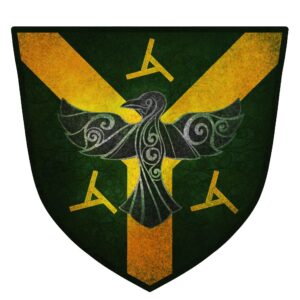
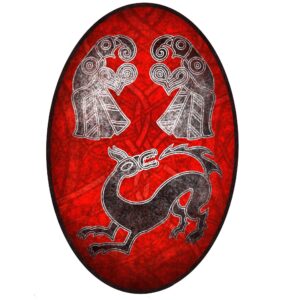
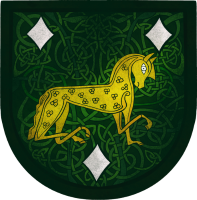
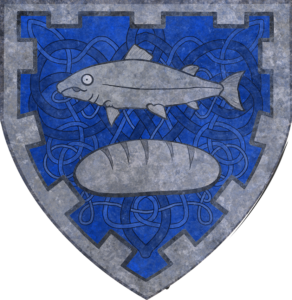
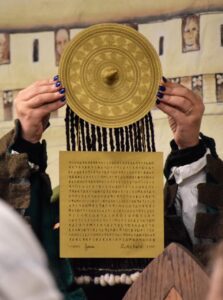
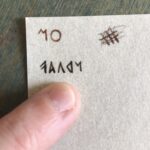
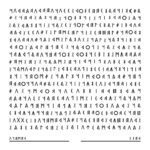
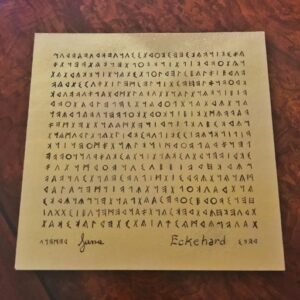
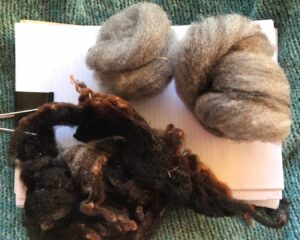
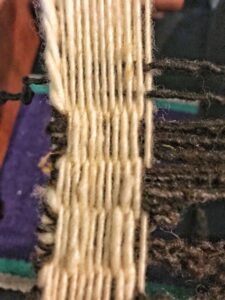
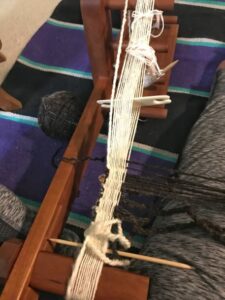
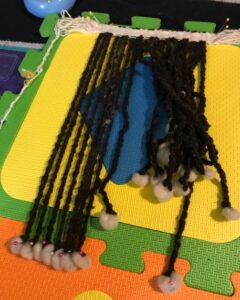
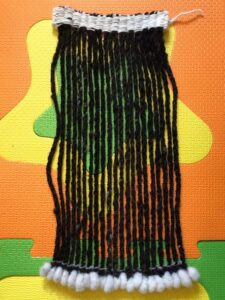 Then, I blocked the whole piece. Instead of soaking the piece, I pinned it to the correct length and sprayed it with a squirt bottle, sopping up the extra water with towels. Once it was dry, I wove in all the ends except one, which I left so Aurri could tell the front from the back (as much as there was one).
Then, I blocked the whole piece. Instead of soaking the piece, I pinned it to the correct length and sprayed it with a squirt bottle, sopping up the extra water with towels. Once it was dry, I wove in all the ends except one, which I left so Aurri could tell the front from the back (as much as there was one).